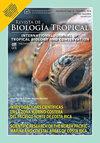移植后麻孢菌属动物区系组成的变化
IF 0.6
4区 生物学
Q4 BIOLOGY
引用次数: 1
摘要
简介:相关动物群构成了珊瑚礁的大部分多样性,并发挥着对珊瑚礁生存至关重要的生态功能。由于Pocillopora珊瑚是一种重要的相关动物,哥斯达黎加Golfo Dulce的珊瑚礁修复工作正在进行中,以保护它们。目的:描述与Pocillopora群体相关的隐动物群和鱼类群落的变化,以更好地了解移植后相关动物群的演替。方法:在Golfo Dulce移植后,对30个苗圃生长的Pocillopora菌落的实验贴片和不含菌落的对照贴片进行8个月的监测。使用SCUBA观察每个群落内的隐动物群和每个斑块内的鱼类,以量化群落的丰度、多样性和群落结构的时间变化。结果:在整个实验过程中,隐动物群的丰度和多样性都有所增加。斜共生的十足类动物数量最多。不同时期隐动物群落的组成不同,刀疤属的鱼类是造成任何差异的主要原因。隐动物和鱼类的丰度和多样性的增加可能反映了珊瑚的生长以及实验区相应的空间和环境复杂性。隐动物群落的组成与其他研究大体一致。然而,高密度的十足目共生体可能表明,如果没有其他Pocillopora群落可供迁移,尽管它们有攻击性,但它们可能会聚集在一起。结论:Pocillopora群体将经历共生体的增加,这可能对移植后珊瑚的健康和生存做出积极贡献。本文章由计算机程序翻译,如有差异,请以英文原文为准。
Change in the composition of fauna associated with Pocillopora spp. (Scleractinia, Pocilloporidae) following transplantation
Introduction: Associated fauna comprises most of the diversity of a coral reef and performs ecological functions essential to the reef’s survival. Since Pocillopora corals harbor an important associated fauna, reef restoration efforts are underway in Golfo Dulce, Costa Rica, to preserve them.
Objective: To describe changes in cryptofauna and fish communities associated with Pocillopora colonies to better understand the succession of associated fauna following transplantation.
Methods: An experimental patch of 30 nursery-grown Pocillopora colonies and a control patch containing no colonies were monitored for 8 months following transplantation in Golfo Dulce. Cryptofauna within each colony and fish within each patch were observed using SCUBA to quantify temporal changes in the abundance, diversity, and community structure of the colonies.
Results: The abundance and diversity of cryptofauna increased throughout the experiment. Obligate symbiont decapods were the most abundant. The composition of the community of cryptofauna differed between periods with fish in the genus Scarus as the main contributor to any differences. The increase in abundance and diversity of cryptofauna and fish may reflect coral growth and the corresponding availability of space and environmental complexity in the experimental patch. The composition of the cryptofauna communities was generally consistent with other studies. However, a high density of decapod symbionts could suggest that without other Pocillopora colonies to move to, they may crowd together despite their aggressive tendencies.
Conclusions: Pocillopora colonies will experience an increase in symbionts that could positively contribute to the health and survival of the coral following transplantation.
求助全文
通过发布文献求助,成功后即可免费获取论文全文。
去求助
来源期刊

Revista De Biologia Tropical
生物-生物学
CiteScore
1.80
自引率
0.00%
发文量
23
审稿时长
4-8 weeks
期刊介绍:
The Revista de Biología Tropical / International Journal of Tropical Biology and Conservation is a mainstream scientific journal published since 1953 and covered by Web of Science; Science Citation Index; Current Contents; Google Scholar; Scopus, SciELO and nearly 50 additional indices.
A double blind system guarantees you a fair evaluation, and our world class editorial and scientific boards provides a first decision in three working days. The journal is Full Open Access and is widely read where your article can have the highest real impact.
Since its beginning in 1953, the Revista follows these principles: objective and independent evaluation of all manuscripts; transparency in all processes; ethical use of procedures, data, specimens and subjects; fair treatment of all parties; and absolute predominance of scientific rigor over any other aspect.
 求助内容:
求助内容: 应助结果提醒方式:
应助结果提醒方式:


